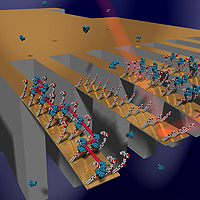Home > Press > UCL research reveals secrets of superbug-busting antibiotic
 |
Abstract:
This week Nature Nanotechnology journal reveals how scientists from the London Centre for Nanotechnology (LCN) at UCL are using a novel nanomechanical approach to investigate the workings of vancomycin, one of the few antibiotics that can be used to combat so-called ‘superbugs', such as MRSA.
UCL research reveals secrets of superbug-busting antibiotic
London, UK | Posted on October 13th, 2008The researchers, led by Dr Rachel McKendry and Professor Gabriel Aeppli, developed ultra-sensitive probes capable of providing new insight into how antibiotics work, paving the way for the development of more effective new drugs.
"There has been an alarming growth in antibiotic-resistant hospital superbugs such as MRSA and vancomycin-resistant Enterococci (VRE)," said Dr McKendry. "This is a major global health problem and is driving the development of new technologies to investigate antibiotics and how they work.
"The cell wall of these bugs is weakened by the antibiotic, ultimately killing the bacteria," she continued.
"Our research on cantilever sensors - tiny levers no wider than a human hair - suggests that the cell wall is disrupted by a combination of a local antibiotic and a polymer known as a mucopeptide binding together, and the spatial mechanical connectivity of these events.
"Investigating both these binding and mechanical influences on the cells' structure could lead to the development of more powerful and effective antibiotics in future."
During the study Dr McKendry, Joseph Ndieyira, Moyu Watari and co-workers used these cantilever arrays to examine the process that ordinarily takes place in the body when vancomycin binds itself to the surface of the bacteria.
They coated the cantilever array with polymers known as mucopeptides from bacterial cell walls and found that, as the antibiotic attaches itself it generates a surface stress on the bacteria, which can be detected by a tiny bending of the cantilever sensors.
The team suggests that this stress contributes to the disruption of the cell walls and the breakdown of the bacteria.
The interdisciplinary team went on to compare how vancomycin interacts with both non-resistant and resistant strains of bacteria. The ‘superbugs' are resistant to antibiotics because of a simple mutation that deletes a single hydrogen bond from the structure of their cell walls.
This small change makes it approximately 1,000 times harder for the antibiotic to attach itself to the bug, leaving it much less able to disrupt the cells' structure, and therefore therapeutically ineffective.
"This work at the LCN demonstrates the effectiveness of silicon-based cantilevers for drug screening applications," says Professor Gabriel Aeppli, Director of the LCN.
"According to the Health Protection Agency, during 2007 there were around 7,000 cases of MRSA and more than a thousand cases of VRE in England alone. In recent decades the introduction of new antibiotics has slowed to a trickle but without effective new drugs the number of these fatal infections will increase."
The research was funded by the EPSRC (Speculative Engineering Programme), the IRC in Nanotechnology (Cambridge, UCL and Bristol), the Royal Society and the BBSRC.
####
For more information, please click here
Copyright © University College London
If you have a comment, please Contact us.Issuers of news releases, not 7th Wave, Inc. or Nanotechnology Now, are solely responsible for the accuracy of the content.
| Related News Press |
News and information
![]() Researchers develop molecular qubits that communicate at telecom frequencies October 3rd, 2025
Researchers develop molecular qubits that communicate at telecom frequencies October 3rd, 2025
![]() Next-generation quantum communication October 3rd, 2025
Next-generation quantum communication October 3rd, 2025
![]() "Nanoreactor" cage uses visible light for catalytic and ultra-selective cross-cycloadditions October 3rd, 2025
"Nanoreactor" cage uses visible light for catalytic and ultra-selective cross-cycloadditions October 3rd, 2025
Nanomedicine
![]() New molecular technology targets tumors and simultaneously silences two ‘undruggable’ cancer genes August 8th, 2025
New molecular technology targets tumors and simultaneously silences two ‘undruggable’ cancer genes August 8th, 2025
![]() New imaging approach transforms study of bacterial biofilms August 8th, 2025
New imaging approach transforms study of bacterial biofilms August 8th, 2025
![]() Cambridge chemists discover simple way to build bigger molecules – one carbon at a time June 6th, 2025
Cambridge chemists discover simple way to build bigger molecules – one carbon at a time June 6th, 2025
![]() Electrifying results shed light on graphene foam as a potential material for lab grown cartilage June 6th, 2025
Electrifying results shed light on graphene foam as a potential material for lab grown cartilage June 6th, 2025
Discoveries
![]() Researchers develop molecular qubits that communicate at telecom frequencies October 3rd, 2025
Researchers develop molecular qubits that communicate at telecom frequencies October 3rd, 2025
![]() Next-generation quantum communication October 3rd, 2025
Next-generation quantum communication October 3rd, 2025
![]() "Nanoreactor" cage uses visible light for catalytic and ultra-selective cross-cycloadditions October 3rd, 2025
"Nanoreactor" cage uses visible light for catalytic and ultra-selective cross-cycloadditions October 3rd, 2025
Announcements
![]() Rice membrane extracts lithium from brines with greater speed, less waste October 3rd, 2025
Rice membrane extracts lithium from brines with greater speed, less waste October 3rd, 2025
![]() Researchers develop molecular qubits that communicate at telecom frequencies October 3rd, 2025
Researchers develop molecular qubits that communicate at telecom frequencies October 3rd, 2025
![]() Next-generation quantum communication October 3rd, 2025
Next-generation quantum communication October 3rd, 2025
![]() "Nanoreactor" cage uses visible light for catalytic and ultra-selective cross-cycloadditions October 3rd, 2025
"Nanoreactor" cage uses visible light for catalytic and ultra-selective cross-cycloadditions October 3rd, 2025
|
|
||
|
|
||
| The latest news from around the world, FREE | ||
|
|
||
|
|
||
| Premium Products | ||
|
|
||
|
Only the news you want to read!
Learn More |
||
|
|
||
|
Full-service, expert consulting
Learn More |
||
|
|
||








